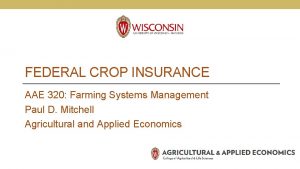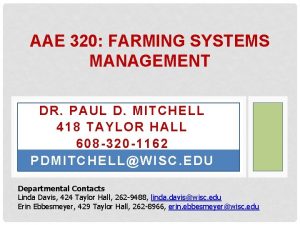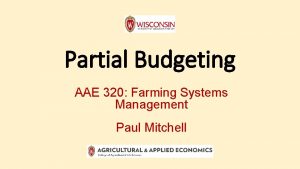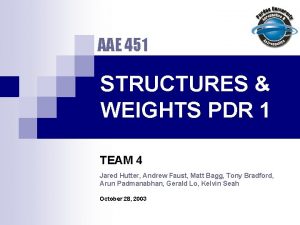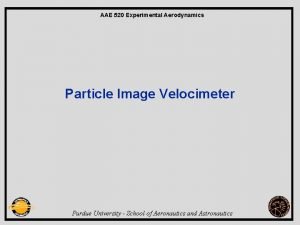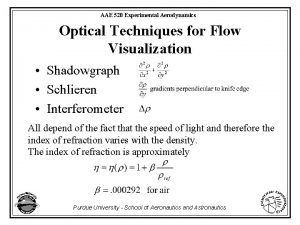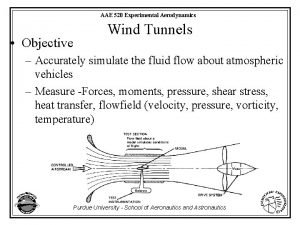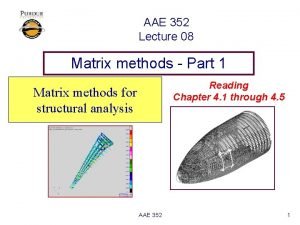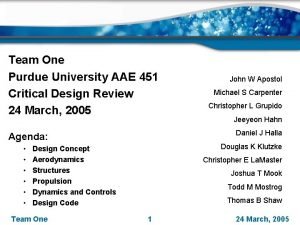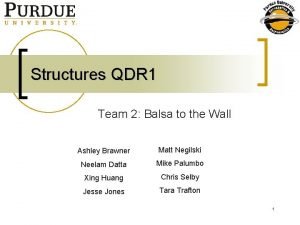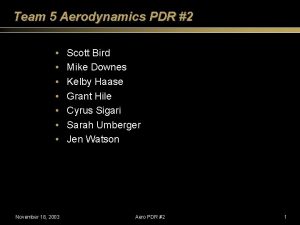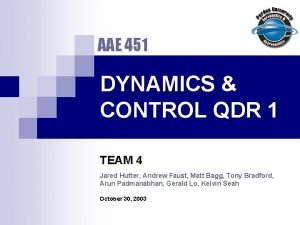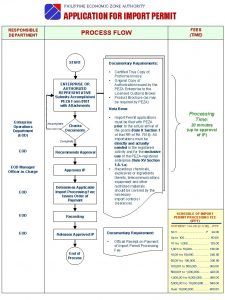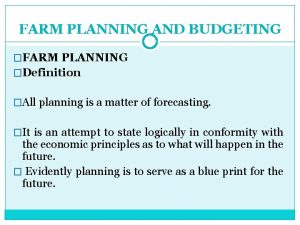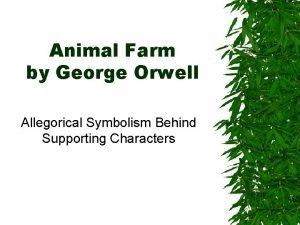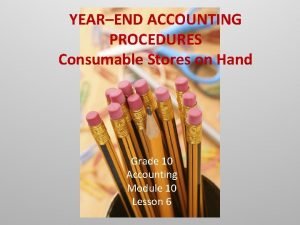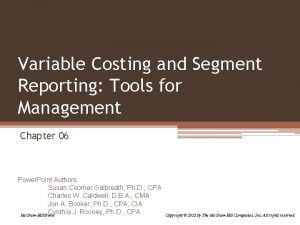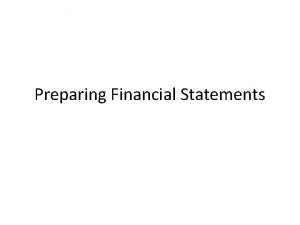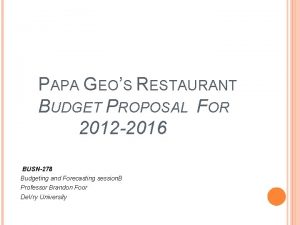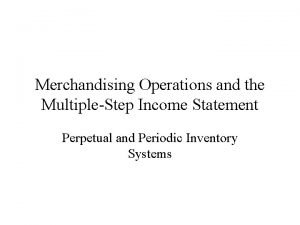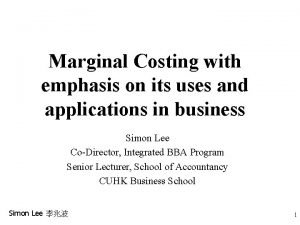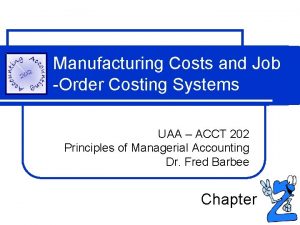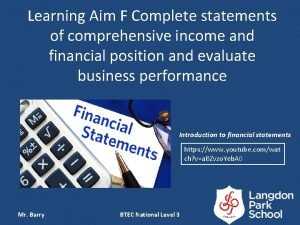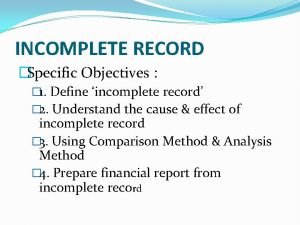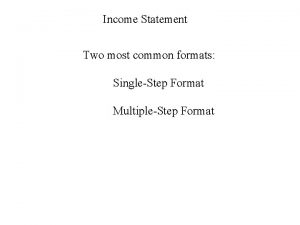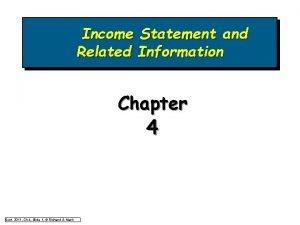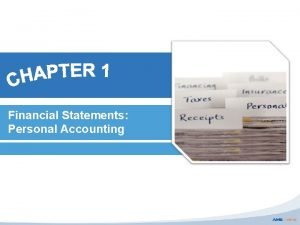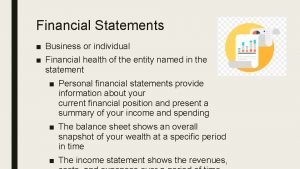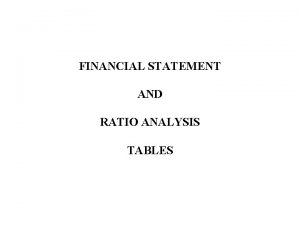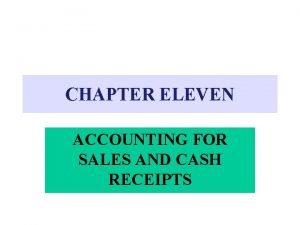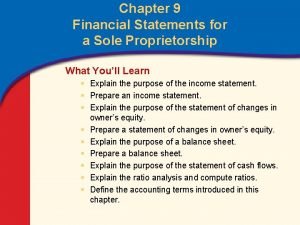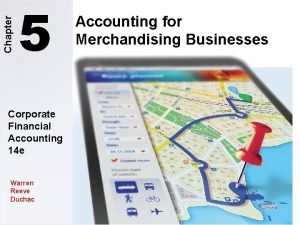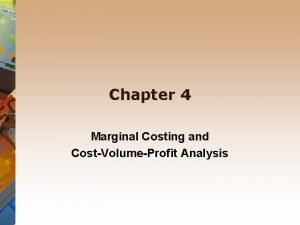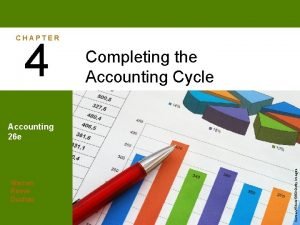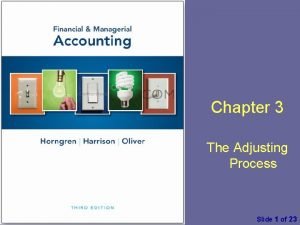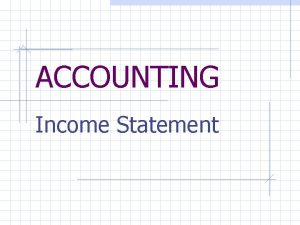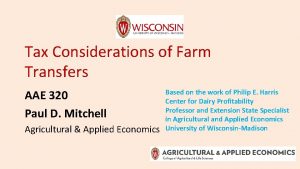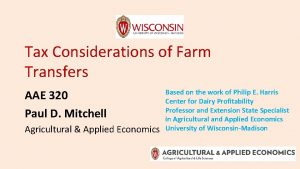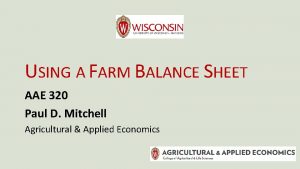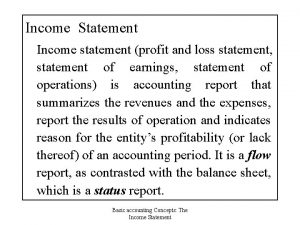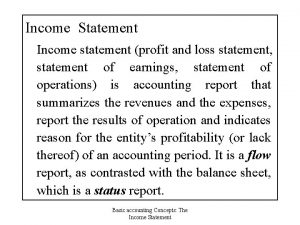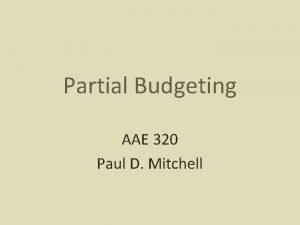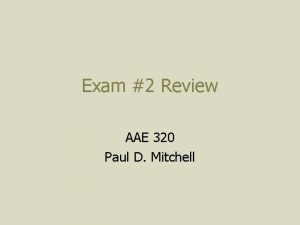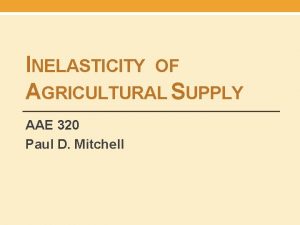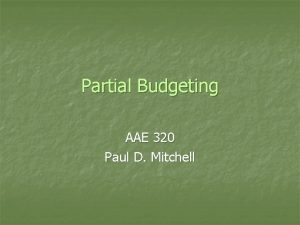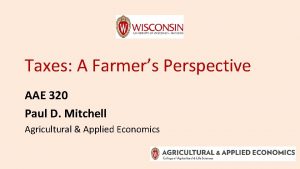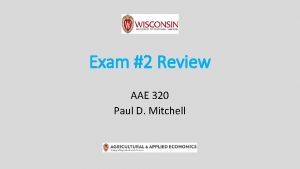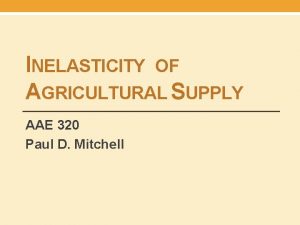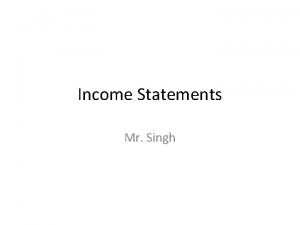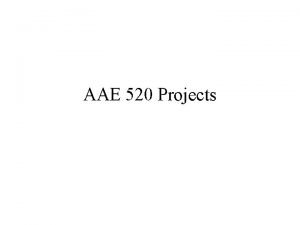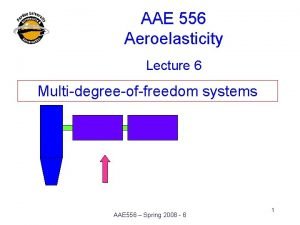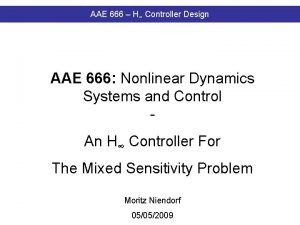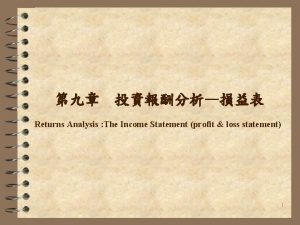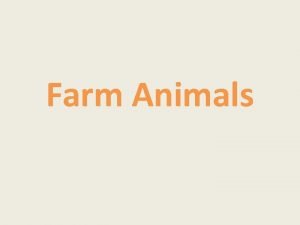FARM INCOME STATEMENT ANALYSIS AAE 320 Paul D
















































- Slides: 48

FARM INCOME STATEMENT ANALYSIS AAE 320 Paul D. Mitchell

Goal • Overview accounting Income Statement as it pertains to agricultural operations • How to prepare and/or read one • How to use one to calculate rates of return

Income Statement • Income Statement: Record of revenues and expenses over a period of time • Remember: Balance Sheet is statement of assets, liabilities and equity at a point in time • Other names for an income statement • Operating Statement • Profit and Loss Statement (P & L) • Income = Revenue minus Costs • Question it answers: Did you make money last year?

Income Statement • Income = Revenue minus Costs • Revenue consists of Cash Revenue and Non- Cash Revenue • Costs consist of Cash Costs and Non-Cash Costs

Cash Revenue • Account for all business revenue earned during the period: cash and non-cash • Cash Revenue • Crop sales • Feeder livestock sales • Crop and Livestock product sales • Government program payments, including crop insurance and disaster payments • Anything you sell! • Will generally have a record for checks received

Non-Cash Revenue • Will not always have records for these revenues • Inventory Changes for commodities ready for sale • Grain, feeder livestock • Accrual basis: value of ending inventory minus value of beginning inventory • Accounts Receivable: ending balance minus beginning balance • Miscellaneous: Non-cash payments in kind, trades, custom harvest arrangements, etc.

Revenue: Special Agricultural Cases • Gain/Loss from sale of culled breeding livestock or milk cows • Treat as Cash Revenue, a normal part of production process • Typically do not treat it as gain/loss from sale of a capital asset • Change in value of raised breeding livestock or milk cows (calf to heifer, heifer to cow) • Treat the increase in value of raised livestock as an increase in revenue • Like inventory changes: Use the book value for each animal type, then do ending value minus beginning value for herd

Revenue: Special Agricultural Cases • Gains or Losses on Sales of Capital Assets are treated as revenue • Land: Selling Price minus Selling Costs • Revenue changes only due to price changes • Selling costs: often there are deferred taxes due • Depreciable Assets: Selling Price minus “Book” Value” (value according to your depreciation schedule) • Revenue changes due to price changes and errors in estimating depreciation • This adjusts revenue for “errors” in depreciation, which are very common

Cash Expenses • Account for all business expenses incurred during the period: cash and non-cash • Purchased inputs: fertilizer, seed, fuel, chemicals, feeder livestock, feed, etc. • Labor and services • Repairs and maintenance • Property taxes, insurance, etc. • Everything you buy for the farm!!! • Will generally have a record for checks written

Non-Cash Expenses • Will not always have records for these expenses • Depreciation • All capital assets (buildings, tractors, etc. ) • Breeding livestock, milk cows, perennial crops • Cost of production to account for, even if you don’t pay cash • Accounts Payable • Ending accounts payable balance minus beginning accounts payable balance

Prepaid Expenses • Expenses paid in previous tax period for production during the current tax period • Common examples: fertilizer, seed, feed etc. bought in previous tax year for this crop year • Goal: to put expenses into the year they were used to produce crops/livestock • Expenses for This Year = Prepaid Expense Last Year – Prepaid Expense This Year • Main idea: put expenses into the crop year the purchased inputs are used

Accrued Expenses • Cash interest paid • Add accrued interest owed • Subtract interest prepaid • Property taxes paid • Add accrued taxes owed • Subtract taxes prepaid • Income taxes owed • Should estimate, but that very difficult • Do Income Statement as pre-tax income • Do after-tax Income Statement later after pay taxes

Income Statement • Main Idea • Revenue – Expenses = Net Farm Income from Operations • Include unpaid labor & management & net gains from sale of capital assets = Net Farm Income • Trying to separate income from production activities versus income from investment activities • This is the general idea, many variations due to differences in the non-cash costs and noncash revenues included

Cash Accounting and Accrual Adjustments • Most farms use cash accounting for taxes • Problems: Prepaid expanses and sales in following tax year are common • Buy many inputs (seed, fertilizer, chemicals, feed, fuel) in one year, but use them the next year • Harvest crops and livestock born/raised in one year, but sell in next year • Tax management: buy inputs and make sales to reduce taxable income – cannot use tax accounting to determine profitability of specific enterprises • Do not use costs and revenue from 2017 taxes to calculate your profits from the 2017 corn crop • Accrual Adjustments: put costs and revenues into the right year to determine profitability

Accrual Adjustment of Cash Basis Income Statement • Accrual accounting: the business standard: GAAP • Accrual accounting: more accurate and useful for decision making: puts costs and revenue in the right years • Cash accounting simple and has tax advantages • Farms end up with two sets of accounting records if do it “right”: cash for taxes, accrual for decisions • Farms must create cash accounting records for tax purposes, then can develop an accrual adjusted cash basis income statement from them • Farm accountants work out the details

Simple Example to Illustrate Cash versus Accrual Accounting • If 2017 a high revenue year, to lower 2017 taxes • Increase prepaid expenses: Buy more than usual inputs in 2017 for 2018 (fertilizer, seed, fuel) • Sell 2017 grain after Dec 31, 2017 so less 2017 income • Just “kicks the can down the road” but eventually a low income year happens and you can “catch up” • To calculate profits from growing corn in 2017 • Do not include revenue from corn grown in 2016 and sold in 2017, but do include revenue from corn sold in 2018 and grown in 2017 • Include costs paid in 2016 for inputs used in 2017, but not costs paid in 2017 for inputs used in 2018

Uses for Income Statement • See if made a business had a profit or a loss, but really want to know profitability • Profitability: normalize for size to see if there is efficient use of resources to produce income • Five Measures commonly used • Net Farm Income from Operations • Net Farm Income • Rate of Return on Assets • Rate of Return on Equity • Operating Profit Ratio Should be Accrual Adjusted

Calculating Farm Income: Revenue • You decide what non-cash sources to include and whether it’s accrual adjusted or not • 1) Selling things: self explanatory • 2) Capital Gains: Selling of capital (non-current) assets for prices different than their basis • Sell land for different price than original cost • Depreciable assets: selling for price different than remaining basis

Calculating Farm Income: Cost • 1) Operating Costs: You decide what non-cash costs to include and whether to use accrual adjustments • 2) Interest: separate it out as operating expense • Need to account for interest in some measures • 3) Unpaid Labor and Management: how much you “pay yourself” for labor and management • Need to account for in some measures

Net Farm Income from Operations (NFIf. O) • NFIf. O = Revenue – Operating Costs – Interest • NFIf. O = Income made by farm operation • Does not include investment income from capital asset sales: depreciation should already be included as a non-cash expense • Does not include paying the operator/manager for time and labor

Net Farm Income (NFI) • NFI = Revenue – Operating Costs – Interest – Unpaid Labor & Management + Capital Gains • Income generated by farm business after paying all expenses (operation & investment activities) • Includes net gain from sale of capital assets • Includes paying for owner/operator’s time and management • NFI = NFIf. O – Unpaid Labor & Management + Capital Gains

NFIf. O vs NFI • A farm is a mix of different activities: labor, management, investment, financing, etc. • NFIf. O: trying to get at the crop growing and livestock part of the operation, not investment or management • NFI: tries to get at all the farm business: pay yourself for management, plus investment earnings included

Return on Assets (ROA) • ROA = Revenue – Operating Costs – Unpaid Labor & Mngmt + Capital Gains • ROA = NFI + Interest • Income generated by all Farm Assets, including investment income • Don’t Subtract Interest • Interest = cost of using someone else’s money so your farm can have more assets than just what you can own with your equity • ROA wants to calculate income generated by all assets, yours and other people’s • Other terms: Return to Capital

Return on Assets (ROA) • Estimate cost of Unpaid Labor and Management • What it would cost to hire someone to do all the currently unpaid labor and management? • What would you/family make at your next best alternatives (opportunity costs)? • Removing Unpaid Labor and Management arbitrary, but important • Whatever value you choose changes estimated ROA • If ignore unpaid labor and management (many do), will get higher ROA • Know these issues before you compare with other businesses and with market returns

Rate of Return on Assets (ROROA) • ROA compared to size of business • How much income is the farm generating relative to the amount of assets used? • ROROA = (ROA/Average Assets) x 100 • Average Assets = average of assets over the time period of the Income Statement • Go to Balance sheet and use average of total assets (current and non-current) at start and end of period • Rates of return are why Balance Sheet and Income Statement go together

Rate of Return on Assets (ROROA) • ROROA = (ROA/Average Assets) x 100 • Average Assets = “size” of business during the accounting period • Which basis for asset valuation: cost or market? • Market basis to compare farms and to compare to liquidating and getting market rates of return on financial investments • Use cost basis to look at your trend over years • Compare ROROA only if done in same way, especially asset valuation • Do not include non-farm assets and income

Return on Equity (ROE) • ROE = Revenue – Operating Costs – Interest – Unpaid Labor and Management + Capital Gains • ROE = ROA – Interest • ROE = NFI • Of all the income generated by the Farm Assets, the part that goes to you as holder of equity in the business • Return on your equity invested in the farm

Rate of Return on Equity (ROROE) • ROROE = (ROE/Average Equity) x 100 • Average Equity = average of equity at the beginning and end of the period • Obtain from Balance Sheet • Like ROROA, except use ROE, not ROA • ROE removes Interest from ROA • Interest is farm income to pay for debt equity • Interest is the “ROE” for the bank, and the Interest Rate is roughly the bank’s “ROROE”

ROROA, ROROE and Interest Rate • Interest the only difference between ROE and ROA • If Rate of Return on Assets > Interest Rate, Rate of Return on Equity > Rate of Return on Assets • If Rate of Return on Assets < Interest Rate, Rate of Return on Equity < Rate of Return on Assets • If ROROA > Interest Rate, then extra generated from use of external funds goes to increase ROROE

Operating Profit Margin Ratio (“Profit Margin”) • Operating profit as percent of Revenue • Operating profit = Return on Assets • Operating Profit Margin Ratio = ROA/Total Revenue • Of all revenue generated by the business, how much does the business keep? • Low Profit Margin: improve ratio first (by lowering costs) before expansion • High Profit Margin: expansion may make sense

Summary of Farm Income Definitions • Net Farm Income from Operations (NFIf. O) = Revenue – Operating Costs – Interest • Net Farm Income (NFI) = Revenue – Operating. Costs – Interest – Unpaid. Labr. Mngmt + Cap. Gains • NFI = NFIf. O – Unpaid. Labr. Mngmt + Cap. Gains • Return on Assets (ROA) = Revenue – Operating. Costs – Unpaid. Labr. Mngmt + Cap. Gains • ROA = NFIf. O + Interest – Unpaid. Labr. Mngmt + Cap. Gains • ROA = NFI + Interest • Return on Equity (ROE) = Revenue – Operating. Costs – Interest – Unpaid. Labr. Mngmt + Cap. Gains • ROE = ROA – Interest • ROE = NFI

Farm Income: Final Comment • When you do your accounting, or pay some one to do it, and you calculate your farm income • You decide how you want to deal with non-cash costs, non-cash revenues, depreciation, inventory changes, accrued expenses, prepaid expenses, accrual adjustments and unpaid labor and management costs for yourself and your family • When you compare yourself to other farmers, know how they deal with these same things and make adjustments if the comparison is important

Summary • How to develop an Income Statement • Accrual Accounting • Accrual Adjusted Cash Accounting • Measures from Income Statement • Net Farm Income from Operations • Return on Assets and Rate of Return on Assets • Return on Equity and Rate of Return on Equity • Profit Margin • Look at example rates and margins • Look at example income statement

Rates of Return in Dairy • UW Center for Dairy Profitability http: //cdp. wisc. edu/pdf/02 bench. pdf http: //cdp. wisc. edu/Financial%20 Benchmarks. htm • Two methods • Assets at Cost Basis with Tax Depreciation • Assets at Market Basis with Economic Depreciation • Does NOT include cost of unpaid labor and management or opportunity cost of owner equity

Average Profitability in WI Dairy Cost Basis and Tax Depreciation 2002 2001 2000 ROROA 4. 00% 10. 01% 7. 91% ROROE -1. 69% 16. 15% 9. 07% 4. 99% 12. 38% 10. 25% Profit Margin Market Value and Economic Depreciation 2002 2001 2000 ROROA 2. 17% 5. 65% 4. 24% ROROE 0. 05% 4. 82% 2. 34% Profit Margin 5. 79% 13. 31% 10. 52%

ROROA in WI Dairy: Ag. FA Farms Year ROROA 1995 5. 57% 1996 5. 36% 1997 5. 42% 2005 2006 2007 6. 77% 3. 25% 8. 39% 1998 1999 2000 2001 2002 2008 2009 6. 49% -1. 65% 9. 20% 7. 56% 4. 24% 5. 65% 2. 17% 2002 Range of ROROA Range % Farms < 0% 35. 5% 0% - 2. 5% 20. 1% 2. 5% - 5% 16. 3% 5% - 7. 5% 14. 0% 7. 5% - 10% 7. 1% > 10% 7. 1% * Assets at Market Value and Economic Depreciation

2009: A Bad Year for Dairy • 473 Ag. FA farms in 2009 NFI ROROA ROROE • Top 40%: $77, 098 3. 32% 2. 63% • The Rest: -$23, 794 -7. 84% -2. 83%

Range of ROROA in 2009 Even in Bad years, some farms make money Source: http: //cdp. wisc. edu/pdf/09 bench. pdf

More Recent WI Dairy Data 250 famers for 2014 -2016 Herd Size <50 50 -99 100 -199 200 -499 500 -999 >1, 000 All ROA 0. 5% 1. 6% 2. 4% 4. 0% 4. 9% 6. 8% 2. 2% Profit Margin 3. 5% 8. 9% 8. 7% 10. 6% 12. 4% 13. 3% 9. 0% Debt to Asset 15. 6% 25. 5% 45. 6% 59. 1% 62. 0% 62. 2% Source: https: //cdp. wisc. edu/wp-content/uploads/Profitability-14_15_16 -C-1. pdf • Larger farms have higher ROA, but more leveraged, so means they don’t capture as much of the ROA • Write-up does not explain asset valuation method, non-cash costs used and unpaid labor and management assumptions

More Recent WI Dairy Data Distribution of ROA by Herd Size <50 50 -99 100 -199 200 -499 500 -999 >1, 000 top 10% 4. 6% 9. 1% 9. 6% 12. 3% 14. 1% 15. 4% top 25% 1. 9% 4. 2% 5. 7% 8. 1% 9. 6% 9. 0% median 0. 5% 1. 6% 2. 4% 4. 0% 4. 9% 6. 8% bottom 25% -1. 5% -0. 6% 0. 1% 1. 2% 2. 0% 2. 4% Source: https: //cdp. wisc. edu/wp-content/uploads/Profitability-14_15_16 -C-1. pdf • Even in good years, some farms lose money • Even in bad years, some farms make money bottom 10% -3. 8% -3. 2% -2. 5% -2. 0% -0. 9% 0. 4%

IA 1990 -1998 by Type and 2000 -2006 IA 1990 -1998 ROROA ROROE Profit Margin Grain 7. 3% 6. 0% 22. 3% Hog 7. 4% 6. 3% 20. 9% Fed Beef 6. 0% 4. 6% 23. 1% Cow-Calf 4. 5% 2. 6% 16. 0% Dairy 7. 6% 7. 5% 21. 1% ROROA ROROE Profit Margin Top 20% 12. 8% 15. 1% 22. 9% 3. 45 0. 41 Upper 20 -40% 11. 4% 12. 7% 20. 1% 3. 44 0. 37 Middle 20% 7. 9% 8. 1% 17. 0% 2. 50 0. 37 Lower 20 -40% 9. 2% 11. 5% 16. 7% 1. 87 0. 36 Lowest 20% 4. 4% 2. 9% 9. 0% 1. 62 0. 44 IA 2000 -2006 Source: http: //www. extension. iastate. edu/Publications/FM 1883. pdf Current Ratio Debt to Asset

IL and MN 2004 IL 2004 ROROA ROROE Grain 6. 2% 7. 1% Hog 13. 4% 19. 2% Beef 2. 9% 2. 6% Dairy 9. 6% 11. 2% MN 2004 ROROA ROROE Profit Margin Average 8. 0% 10. 9% 17. 6% Top 20% 13. 4% 20. 8% 26. 0% Btm 20% -2. 7% -18. 0% -8. 0%


Source: http: //farmdocdaily. illinois. edu/2016/10/financial-performance-of-illinois-grain-farms. html

Farm Accounting Programs (from Jenny Vanderlin, UW CDP) • AAIMS: Agricultural Accounting and Management Information System • UW CDP developed and CDP, UWEX supports, cheap ($150) for dairy only • Ag. Manager by Agri. Solutions • General farm accounting, Farm Credit Services • Redwing sells Center. Point and Perception • More expensive, used by ag accounting firms • Center. Point is newer, more for farmers

Farm Accounting Programs (from Jenny Vanderlin, UW CDP) • Several Others: Farm Fund$, Peach. Tree, Quick. Books, Quicken, Money. Works • CDP and UWEX do presentations and workshops for farmers to learn more about these • Heart of the Farm, Annie’s Project • UWEX as requested

WI Farm Management Associations • Fox Valley Farm Management • http: //fvfma. com/ in Appleton, WI with about 700 members • Lakeshore Farm Management • http: //www. lakeshorefarmmanagement. com/ in Valders, WI with about 1, 000 members • Services provided to members 1. Tax preparation, management and planning 2. Computerized and hand record-keeping systems 3. Scheduled "on the farm" consultations 4. Yearly farm business summary and analysis • Ag Lenders often do #1 and #2, UW Extension agents ofetn do #3, UW CDP does #4

More Information • Web pages I gave with Balance Sheets • UWEX Center for Dairy Profitability • Farm. DOC IL Extension • Center for Farm Financial Management MN Ex • Ag. Decision Maker IA Extension • Farm Financial Standards Council • UW CDP soon to relase FARMBENCH to replace Agriculture Financial Advisor (Ag. FA) • Other states have comparable groups
 Aae 320
Aae 320 Aae 320 uw madison
Aae 320 uw madison Aae 320
Aae 320 Non operating income
Non operating income Aae 508 purdue
Aae 508 purdue Aae 520
Aae 520 Aae 520
Aae 520 Aae 520
Aae 520 Aae design
Aae design Aae 352
Aae 352 Aae 251
Aae 251 Aae 451
Aae 451 Aae glass tutorial
Aae glass tutorial Aae 421
Aae 421 Purdue aae 590
Purdue aae 590 Aae 421
Aae 421 Banking financial statement analysis
Banking financial statement analysis Real gdp per capita formula
Real gdp per capita formula Carrying value formula
Carrying value formula Chapter 16 accounting for income taxes
Chapter 16 accounting for income taxes 8105 peza
8105 peza Difference between complete budgeting and partial budgeting
Difference between complete budgeting and partial budgeting What was the problem with the farm tools in animal farm
What was the problem with the farm tools in animal farm Who does mollie represent in animal farm
Who does mollie represent in animal farm Consumable stores on hand example
Consumable stores on hand example Advantages of marginal costing
Advantages of marginal costing Absorption costing income statement
Absorption costing income statement Accounts payable worksheet
Accounts payable worksheet Pro forma income statement example
Pro forma income statement example Balance sheet title
Balance sheet title Balance sheet restaurant
Balance sheet restaurant Another name for income statement
Another name for income statement Income statement perpetual
Income statement perpetual Marginal cost income statement
Marginal cost income statement Dm + dl + moh
Dm + dl + moh Statement of comprehensive income btec business
Statement of comprehensive income btec business What is discount allowed
What is discount allowed Statement of retained earnings
Statement of retained earnings Single step income statement
Single step income statement Accrual accounting
Accrual accounting Hrsuq4wcd0g -site:youtube.com
Hrsuq4wcd0g -site:youtube.com Financial ratio analysis table
Financial ratio analysis table Standardized income statement
Standardized income statement Four column ledger example
Four column ledger example Financial statement of sole proprietorship
Financial statement of sole proprietorship Example of multi step income statement
Example of multi step income statement Profit volume chart example
Profit volume chart example Kelly consulting end of period spreadsheet
Kelly consulting end of period spreadsheet Income statement in financial accounting
Income statement in financial accounting
